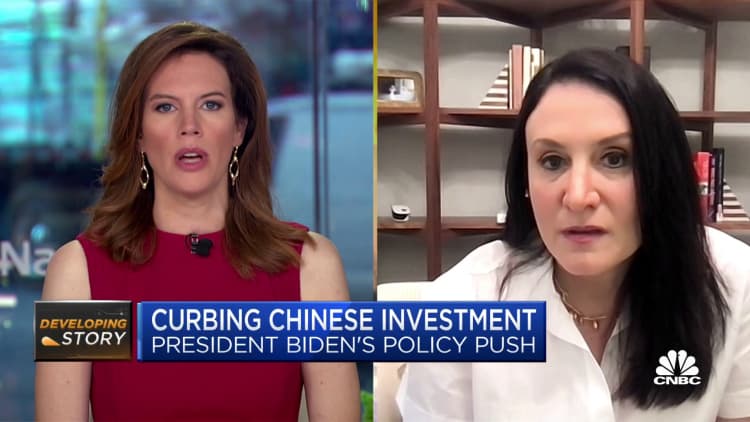The U.S. and Chinese flags hang outside the Goldman Sachs headquarters in New York on Dec. 16, 2008.
Chris Hondros | Getty Images News | Getty Images
BEIJING — The Biden administration’s long-awaited executive order on U.S. investments in Chinese companies leaves open plenty of questions on how it will be implemented.
Its 45-day public comment period gives U.S. investors significant potential to influence any final regulation, analysts said.
“The executive order obviously gives an outline of what the program’s scope is going to be like,” said Brian P. Curran, a partner, global regulatory at law firm Hogan Lovells in Washington, D.C.
“It’s not even a proposed rule. It’s not a final rule.”
U.S. President Joe Biden on Wednesday signed an executive order aimed at restricting U.S. investments into Chinese semiconductor, quantum computing and artificial intelligence companies over national security concerns.
Treasury Secretary Janet Yellen is mostly responsible for determining the details. Her department has published a fact sheet and a lengthy “Advance Notice of Proposed Rulemaking” with specific questions it would like more information on.
Businesses can share information confidentially as needed, according to the advanced notice, which is set to be formally published on Monday. The notice said it is only a means for sharing the Treasury’s initial considerations, and will be followed by draft regulations.
“The final scope of the restriction, to be defined by the Treasury Department after public consultations, including with U.S. investors in China, will be critical for the enforcement of the order,” said Winston Ma, an adjunct professor at NYU Law and a former managing director of CIC.
So what’s banned?
This week’s announcements don’t explicitly prohibit U.S. investments into Chinese businesses, but the documents indicate what policymakers are focused on.
The U.S. transactions potentially covered include:
- Acquisition of equity interests such as via mergers and acquisitions, private equity and venture capital;
- Greenfield investment;
- Joint ventures;
- Certain debt financing transactions.
The forthcoming regulations are not set to take effect retroactively, the Treasury said. But the Treasury said it may request information about transactions completed or agreed to since the issuance of the executive order.
“We’ve been advising clients leading up to the issuance of the executive order, it does make sense to look at your exposure to the kinds of transactions that have the potential to be covered by the regime,” Curran said.
Any plans to invest in the sectors named in the public materials should come under additional consideration of the risks and how to manage them, he said.

Here are the sectors of concern:
Semiconductors — Treasury is considering a ban on tech that enables production or improvement of advanced integrated circuits; design, fabrication and packaging capabilities for advanced integrated circuits; and installation, or sale to third-party customers, of certain supercomputers.
Treasury is also considering a notification requirement for transactions involving the design, fabrication and packaging of other integrated circuits.
The U.S. government is concerned about tech that will “underpin military innovations,” the advance notice said.
Quantum computing — Treasury is considering a ban on transactions involving the production of quantum computers, sensors and systems.
However, the Treasury said it is considering not to require investors to notify it of transactions in this sector.
The U.S. government is concerned about quantum information technologies that could “compromise encryption and other cybersecurity controls and jeopardize military communications,” the notice said.
Artificial intelligence — Treasury is considering a ban on U.S. investments into the development of software using AI systems designed for exclusive military, government intelligence or mass-surveillance use.
The Treasury said it may also require U.S. persons to notify it if undertaking transactions involved with AI systems for cybersecurity applications, digital forensics tools, control of robotic systems and facial recognition, among others.
However, the Treasury said its intent is not to touch entities that develop AI systems only for consumer applications and other uses that don’t have national security consequences.
What’s allowed
The Treasury said it expects to exclude certain investments into publicly-traded securities or exchange-traded funds.
The following transactions are not set to be included by forthcoming regulation:
- University-to-university research collaborations
- Contracts to buy raw materials
- Intellectual property licensing
- Bank lending and payment processing
- Underwriting
- Debt rating
- Prime brokerage
- Global custody
- Stock research
What’s next
The Treasury is asking for written comments on its advanced notice by Sept. 28.
The notice includes wide-ranging requests for data into investment trends. It also asked questions about effective threshold requirements and definitions, and details about the resulting burdens for U.S. investors: “If such limitations existed or were required, how might investment firms change how they raise capital from U.S. investors, if at all?”
Among the many other questions, the Treasury is asking for areas within the three overarching categories where U.S. investments into Chinese entities would “provide a strategic benefit to the United States, such that continuing such investment would benefit, and not impair, U.S. national security.”
“There is a lot of opportunity for the public’s comment for what should be covered what should not be covered,” said Anne Salladin, a partner, global regulatory, at Hogan Lovells. “It strikes me as an extraordinarily good opportunity for clients to weigh in on that front.”
“This has been under consideration by the administration for a couple of years now,” she said. “One of the things that’s important is to take [the regulatory process] at a slow speed to understand what the ramifications are for U.S. businesses.”
The kind of law that Biden’s [planning], it’s small but it’s important because once the state starts to meddle with these things it creates more dramatic possibilities.
Jonathan Levy
Professor, University of Chicago
Given the lengthy process, forthcoming regulations aren’t expected to take effect until next year.
However, the niche industry of China-based venture capitalists — which raise funds from U.S. investors to invest in Chinese start-ups, many tech-focused — is already struggling.
Fewer than 300 unique U.S.-based investors have participated in China-based VC deals since 2016 each year, with just 64 participants so far this year, according to Pitchbook.
China VC deal activity in the second quarter continued a recent decline, to the lowest since the first quarter of 2017, according to Pitchbook.
The data showed China VC deal activity with U.S.-only investor participation in artificial intelligence has fallen since the first quarter of 2022. Pitchbook recorded barely any such deals in quantum computing since 2021, while semiconductors saw moderate activity through the first half of this year.
The industry and political developments also mark a shift in the overall risk environment.
“The kind of law that Biden’s [planning], it’s small but it’s important because once the state starts to meddle with these things it creates more dramatic possibilities,” said Jonathan Levy, a University of Chicago economic history professor and author of “Ages of American Capitalism: A History of the United States.”
While he said he doesn’t have any sources within the Biden administration, Levy said the latest developments signal to him that the U.S. government doesn’t want the new economic relationship with China “to consist of U.S. investment funds investing in Chinese high tech because we think high tech is kind of a strategic interest.”
“I also think more fundamentally, I don’t know what kind of relationship they have in mind, [but] there’s going to be a new order. We want to shape to some degree what that [order] looks like.”
— CNBC’s Amanda Macias contributed to this report.








































